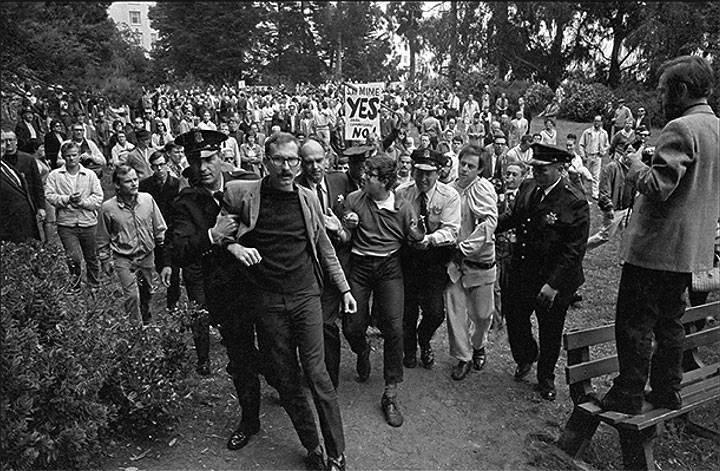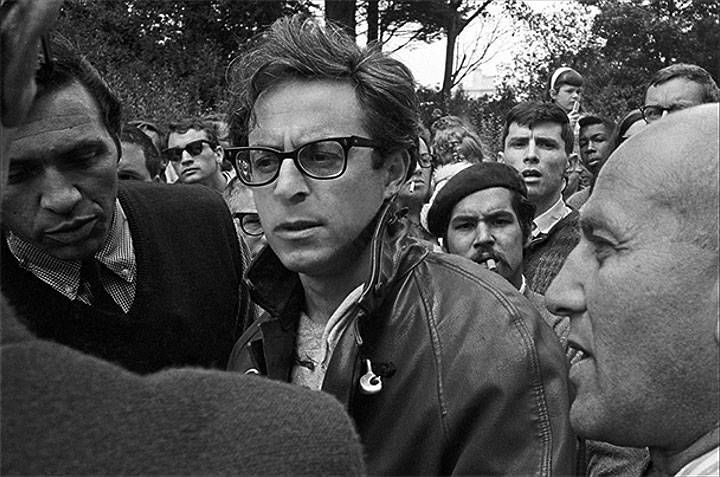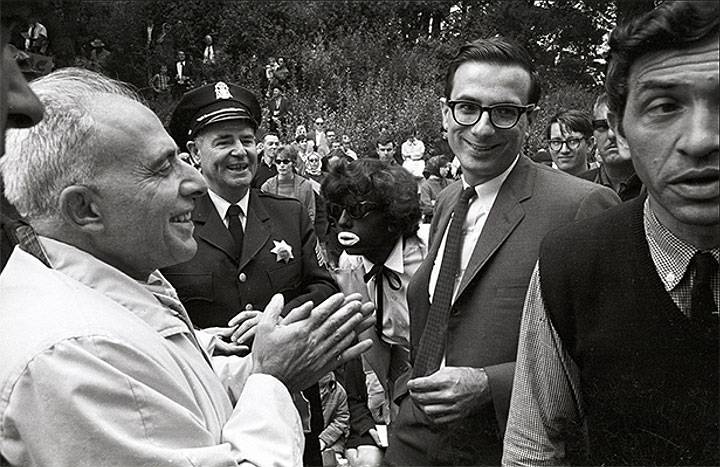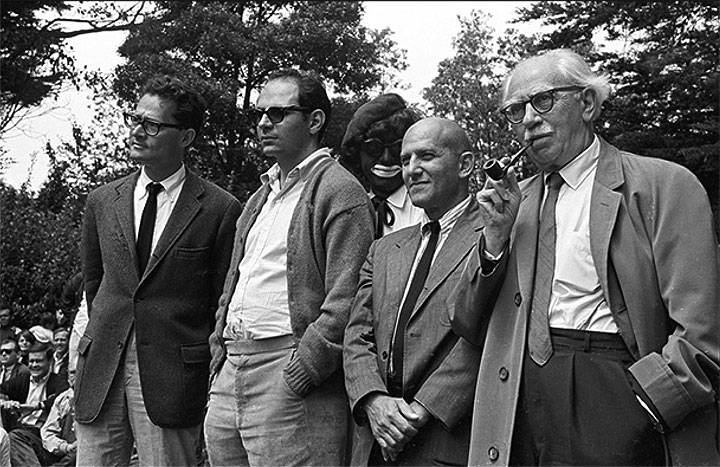San Francisco Mime Troupe Arrested: Difference between revisions
No edit summary |
No edit summary |
||
| (One intermediate revision by the same user not shown) | |||
| Line 32: | Line 32: | ||
Just across the bridge in Berkeley the sizzle of the Free Speech Movement was drawing in even those far removed from the activist core. Igniting the Movement was a renewed sense of personal power and control, hard won in the battle to change the nature of power and authority. The sight of Mario Savio being dragged off the stage by campus police as he attempted to approach the microphone at the Greek Theater a year earlier was not lost on those battling for free speech in SF. Both the Free Speech Movement and SFMT were demonstrating that the essence of protest politics, beyond petitioning and meetings, was taking a stand and putting one's body on the line with the conviction that what was unjust had to be disrupted. | Just across the bridge in Berkeley the sizzle of the Free Speech Movement was drawing in even those far removed from the activist core. Igniting the Movement was a renewed sense of personal power and control, hard won in the battle to change the nature of power and authority. The sight of Mario Savio being dragged off the stage by campus police as he attempted to approach the microphone at the Greek Theater a year earlier was not lost on those battling for free speech in SF. Both the Free Speech Movement and SFMT were demonstrating that the essence of protest politics, beyond petitioning and meetings, was taking a stand and putting one's body on the line with the conviction that what was unjust had to be disrupted. | ||
[[Image:Sf-mime-troupe-tartuffe-preformance-flyer.jpg|360px|right|thumb|'''Mime Troupe flyer for Tartuffe, mid-1960s''']] On the afternoon of August 7th the mood in Lafayette park was explosive, everyone was out, the cops, commissioners, lawyers and the media. While the actors were warming up an audience of a thousand descended on the lawn, drawn in by Bill Graham's (SFMT business manager) publicity. The plan for RGD was to sacrifice arrest. Turning toward the crowd, he explained his circumstances and why the permit was revoked. An animated discussion ensued, with the crowd cheering him on. Then, in a breathtaking moment Davis put on his mask, took up a recorder and began his introduction, “today for your appreciation we perform an arrest” as he leaped into the air. On cue the dour San Francisco police sergeant James Eagen grabbed him. Two others were also arrested for battery and resisting. As the crowd of supporters roared and jeered, a mob drew in closer to the flashpoint of the action as pandemonium broke out. While Davis and others were led away in the clutches of the police, the crowd repeatedly shouted “Brutality”. The show went on, and those that stayed donated generously for the legal fight to come. | [[Image:Sf-mime-troupe-tartuffe-preformance-flyer.jpg|360px|right|thumb|'''Mime Troupe flyer for Tartuffe, mid-1960s''']] On the afternoon of August 7th the mood in Lafayette park was explosive, everyone was out, the cops, commissioners, lawyers and the media. While the actors were warming up an audience of a thousand descended on the lawn, drawn in by Bill Graham's (SFMT business manager) publicity. The plan for RGD was to sacrifice arrest. Turning toward the crowd, he explained his circumstances and why the permit was revoked. An animated discussion ensued, with the crowd cheering him on. Then, in a breathtaking moment Davis put on his mask,took up a recorder and began his introduction, “today for your appreciation we perform an arrest” as he leaped into the air. On cue the dour San Francisco police sergeant James Eagen grabbed him. Two others were also arrested for battery and resisting. As the crowd of supporters roared and jeered, a mob drew in closer to the flashpoint of the action as pandemonium broke out. While Davis and others were led away in the clutches of the police, the crowd repeatedly shouted “Brutality”. The show went on, and those that stayed donated generously for the legal fight to come. | ||
[[Ubu in San Francisco with R.G. Davis| | [[Ubu in San Francisco with R.G. Davis|Ron G. Davis]] went to trial on October 27, 1965 to face the charge of performing in the park without a permit. The trial continued for four days. There was no discussion of constitutional rights. Judge Fitzgerald Ames limited testimony to whether R&P had the legal right to revoke a permit. He cut off discussion after City Attorney Bernard Ward declared that R&P did have that right. Yet even R&P general manager James Lang admitted that there were no rules or regulations for the Commission to follow in granting or denying permits. When the judge found RGD guilty and sentenced him to one year probation and sixty days suspended sentence, Davis burst out in rage “I don't think the issue of free speech was considered, this is like an Iron Curtain country!” | ||
Within days of the arrests, jazz journalist Ralph Gleason reported in the ''SF Chronicle'' that other performers committed to radical leftist ideology such as Lenny Bruce and The Living Theater were being put out of business by cops harassing and jailing the operators of the spaces they performed in. Although a jury acquitted Lenny Bruce in a 1961 arrest for obscenity at the Jazz Workshop in San Francisco, law enforcement agencies continued to monitor his public appearances, resulting in frequent arrests under charges of obscenity. The repression of cultural expression was widespread and endemic to those effectively exposing an unjust system of entrenched power. | Within days of the arrests, jazz journalist Ralph Gleason reported in the ''SF Chronicle'' that other performers committed to radical leftist ideology such as Lenny Bruce and The Living Theater were being put out of business by cops harassing and jailing the operators of the spaces they performed in. Although a jury acquitted Lenny Bruce in a 1961 arrest for obscenity at the Jazz Workshop in San Francisco, law enforcement agencies continued to monitor his public appearances, resulting in frequent arrests under charges of obscenity. The repression of cultural expression was widespread and endemic to those effectively exposing an unjust system of entrenched power. | ||
| Line 46: | Line 46: | ||
In the trial ACLU lawyer Marshall Krause cautioning that it was not within the purview of the commission to judge the appropriateness of a production. He repeatedly argued that the commissioners' actions amounted to censorship and was therefore an invalid suppression of free speech. The district attorney sided with the Commission's findings of guilt on charges of obscenity, which he said, fell short of constitutionally protected speech. Krause retorted that RGD's speech was a protected right, citing the 1964 Supreme Court decision of the film ''The Lovers'': | In the trial ACLU lawyer Marshall Krause cautioning that it was not within the purview of the commission to judge the appropriateness of a production. He repeatedly argued that the commissioners' actions amounted to censorship and was therefore an invalid suppression of free speech. The district attorney sided with the Commission's findings of guilt on charges of obscenity, which he said, fell short of constitutionally protected speech. Krause retorted that RGD's speech was a protected right, citing the 1964 Supreme Court decision of the film ''The Lovers'': | ||
<blockquote>''material dealing with sex in a manner that advocates ideas or that has literary, scientific, artistic value or any other form of social importance may not be branded obscene.''</blockquote> | <blockquote>''material dealing with sex in a manner that advocates ideas or that has literary, scientific, artistic value or any other form of social importance may not be branded obscene.''(Jacobellis v. Ohio, 1964)</blockquote> | ||
Finally in July 1966 Superior Court Judge | Finally in July 1966 Superior Court Judge Koresh, considering the new rules too specific to one group, ruled that the Commission could not censor the content of performances and the SFMT must be permitted the use of parks. The district attorney conceded that revocation of the permit on the basis of content of the play was unconstitutional and agreed to a reversal of the revised park rules. | ||
The arrest of R.G. Davis was the lightning moment in the history of the San Francisco Mime Troupe that served to build an audience for direct action as a form of guerilla theater. The | The arrest of R.G. Davis was the lightning moment in the history of the San Francisco Mime Troupe that served to build an audience for direct action as a form of guerilla theater. The Mime Troupe's resistance and confrontational style, their uniting theater to revolution, and their refusal to be canceled, led to their successful challenges in court. Yet in the years following the court cases, the public use of the parks were restricted by the imposition of fees, effectively limiting their public use. The issues that the SFMT fought for are the same issues before us today. The arrest of RGD demonstrated that government repression is systemic, and it will not hesitate to attack those who oppose it and its policies. | ||
[[Image:Davis-arrest-1 Herbert-Gold,-John-Broderick-(in-blackface),-Sol-Jacobs,--they-were-there-in-support-of-the-mime-troupe.jpg]] | [[Image:Davis-arrest-1 Herbert-Gold,-John-Broderick-(in-blackface),-Sol-Jacobs,--they-were-there-in-support-of-the-mime-troupe.jpg]] | ||
Latest revision as of 20:03, 20 January 2015
Historical Essay
by Jackie Barshak
The arrest, August 7, 1965, in Lafayette Park.
Photo: © Erik Weber, used with permission
Amidst a crowd of supporters shouting “Police Get Out”, R. G. Davis, founder of the San Francisco Mime Troupe (SFMT) was arrested in Lafayette Park on August 7, 1965 as the troupe began their fourth performance of Il Candelaio, a play directed by Davis. Charged with performing without a park permit, Davis was booked at the Hall of Justice and released on $56 bail two hours later. Following the arrests the troupe continued their performance, with literary and civil liberties figures standing in as backdrop. Francis Heisler, Herbert Gold, Paul Jacobs and Alan Meyerson of The Committee maintained group solidarity in the face of punitive threats by police and park staff.
The San Francisco Mime Troupe's battles with the Dept. of Recreation &Parks (R&P) over use of the parks for performances began in 1962. That year they staged their first Commedia dell'arte production, The Dowry in Golden Gate Park but performed it only twice because of R&P's arbitrary prohibition on park performances and their outright denial of permits to perform in Washington Square Park. In 1963 permits to perform in the parks was granted with the warning they they would be revoked if the “entertainment" was deemed to be unsuitable for children, found offensive or inappropriate.
During the arrest: from left to right: Bill Graham, Ron Davis, Luis Valdez, Paul Jacobs.
Photo: © Erik Weber, used with permission
The SFMT's 1965 production of Il Candelaio, The Candlemaker, a bawdy comedy adapted from the 16th century Italian play written by the heretical philosopher Giordano Bruno, was replete with the same radical transgressions as the original script. Bruno wrote Il Candelaio as a polemic against a philosophical and philogical humanism which he saw as empty academic formalism. Troupe members used satire, suggestive gestures and ribald language to parody social conventions then and now. A candle is used to represent a phallus and candelaio is used in colloquial Italian meaning sodomite. The modern script, adapted by Peter Berg, addressed the gender issues of the two leading male characters, one gay the other bisexual, who challenge the rhetorical and philosophical foundations of romantic and courtly love dominant in early modern Europe.
On August 4, 1965 a special meeting of the Rec & Parks Commission was called to McLaren Lodge in Golden Gate Park to discuss staff reports of indecent, offensive and obscene language and gestures seen in performances of Il Candelaio in Golden Gate Park, and to review the conditional permit granted to the SFMT a year earlier. Only three of twelve performances of Il Candelaio scheduled for the parks that summer had been performed. Chairman of the R&P Commission, Walter Haas, heard testimony from his staff and commissioners, with most finding the the performance dull, in poor taste and suggestive in words and gestures. R&P general manager James Lang concluded that the play was “a vulgar travesty, offensive to adults, and incompatible with the minds of youth and children”, although he had not seen it. Counsel to R.G. Davis (RGD), Marvin Stender warned the commissioners that they only had the power to grant but none to cancel a permit, and were therefore not within their rights to censor or refuse permission to perform in the parks. Citing a Supreme Court decision on free speech, Stender made an argument for first amendment protections of theatrical performances and presented 322 signatures on a petition. The barrage of warnings and arguments continued. RGD lashed out, “The Commission has no right to censor the content of a rally presented in the parks...it would be an encroachment of free speech to do so,....on what grounds is the commission trying to stop the performances of commedia dell'arte in the parks, bad taste? When did the commission receive the position of judge of taste or content?”. Sitting stolidly the commissioners said nothing and then voted unanimously to revoke the Mime Troupe's permit to perform in the city's parks. Without missing a beat, twenty members of the troupe stood up and broke into song, “We Shall Overcome”, to flute music, as they emptied into the hallway outside the board room.
Park official, San Francisco cop, John Broderick, Marvin Stender (attorney), and Bill Graham, during the Mime Troupe arrest.
Photo: © Erik Weber, used with permission
Just across the bridge in Berkeley the sizzle of the Free Speech Movement was drawing in even those far removed from the activist core. Igniting the Movement was a renewed sense of personal power and control, hard won in the battle to change the nature of power and authority. The sight of Mario Savio being dragged off the stage by campus police as he attempted to approach the microphone at the Greek Theater a year earlier was not lost on those battling for free speech in SF. Both the Free Speech Movement and SFMT were demonstrating that the essence of protest politics, beyond petitioning and meetings, was taking a stand and putting one's body on the line with the conviction that what was unjust had to be disrupted.
On the afternoon of August 7th the mood in Lafayette park was explosive, everyone was out, the cops, commissioners, lawyers and the media. While the actors were warming up an audience of a thousand descended on the lawn, drawn in by Bill Graham's (SFMT business manager) publicity. The plan for RGD was to sacrifice arrest. Turning toward the crowd, he explained his circumstances and why the permit was revoked. An animated discussion ensued, with the crowd cheering him on. Then, in a breathtaking moment Davis put on his mask,took up a recorder and began his introduction, “today for your appreciation we perform an arrest” as he leaped into the air. On cue the dour San Francisco police sergeant James Eagen grabbed him. Two others were also arrested for battery and resisting. As the crowd of supporters roared and jeered, a mob drew in closer to the flashpoint of the action as pandemonium broke out. While Davis and others were led away in the clutches of the police, the crowd repeatedly shouted “Brutality”. The show went on, and those that stayed donated generously for the legal fight to come.
Ron G. Davis went to trial on October 27, 1965 to face the charge of performing in the park without a permit. The trial continued for four days. There was no discussion of constitutional rights. Judge Fitzgerald Ames limited testimony to whether R&P had the legal right to revoke a permit. He cut off discussion after City Attorney Bernard Ward declared that R&P did have that right. Yet even R&P general manager James Lang admitted that there were no rules or regulations for the Commission to follow in granting or denying permits. When the judge found RGD guilty and sentenced him to one year probation and sixty days suspended sentence, Davis burst out in rage “I don't think the issue of free speech was considered, this is like an Iron Curtain country!”
Within days of the arrests, jazz journalist Ralph Gleason reported in the SF Chronicle that other performers committed to radical leftist ideology such as Lenny Bruce and The Living Theater were being put out of business by cops harassing and jailing the operators of the spaces they performed in. Although a jury acquitted Lenny Bruce in a 1961 arrest for obscenity at the Jazz Workshop in San Francisco, law enforcement agencies continued to monitor his public appearances, resulting in frequent arrests under charges of obscenity. The repression of cultural expression was widespread and endemic to those effectively exposing an unjust system of entrenched power.
In the weeks following the arrest, the SFMT barraged the media with its position about censorship, sending out press releases, organizing press conferences and printing pamphlets. But the backlash against the theater group for its subversive politics was swift and immediate. The jury was not yet in before RGD was banned from theaters and scheduled appearances. On September 24, 1965 a month before the trial began, the troupe's performances at the Gate Theater in Sausalito were canceled without explanation. The theater's manager also evicted them from their rented office space. The troupe's scheduled performance in Mt. Tam Amphitheater, part of the Marin Summer Festival of Arts, was also canceled after the Dept. of State Parks and Recreation declared the troupe “unacceptable for performance in state parks”. Later the ban was rescinded. The Department pressured the sponsoring organization, Atheneum Arts Foundation to screen the troupe's script for “indecencies” but they refused to act as censors. That summer the Bernal Heights Street Fair canceled the troupe's appearance for undisclosed reasons, as did CBS television. R&P was apparently calling around to see who could be induced to ban the Mime Troupe. Corporate media outlets subverted the case with misinformation about the arrest, pronouncing it as obscenity not censorship. With the prevailing view of the SFMT as blasphemous radicals, R&P again denied Davis's request for a permit to perform as he awaited trial. The commissioners doubtlessly reckoned that the San Francisco Mime Troupe would be drained by their continuing need to defend against denied permits and canceled appearances, which would keep them busy in the courts and out of sight of the parks and theaters.
To cover legal fees benefit concerts were organized. The first, in the troupe's Howard Street studio featured Jefferson Airplane, Allen Ginsberg, The Committee, Sandy Bull, The Mothers, Peter Orlovsky, and the John Handy Quintet. It netted $2,000 in donations. The second “Appeal for Continued Freedom of the Arts” was organized by Bill Graham and held at the Fillmore. Over 2,000 people paid $1.50 to hear Big Brother and the Holding Company, the Grateful Dead, Quicksilver Messenger Service and Jefferson Airplane. The financial support of the bands reflected the troupe's mission of convincing artists to stop working for the sake of money, to instead work for the people and social change.
In February 1966, the ACLU lawyers representing the SFMT, Stephen Adams and Marshall Krause filed a lawsuit against the Commission of R&P over the revision of rules and regulations that would create new restrictions for performing in the parks. The revisions to the park code included pre-approval of play summaries, a prohibition on collecting money before or after a performance, the requirement of a uniformed security officer at performances, and the retention of a hold harmless insurance policy. The revised rules granted unilateral authority to the department's general manager to approve or deny all permits. Later that summer the SFMT made requests again to perform in Aquatic Park and Civic Center. R&P manager James Lang denied the requests, but granted the American Nazi Party a permit to hold a rally in Civic Center in October.
In the trial ACLU lawyer Marshall Krause cautioning that it was not within the purview of the commission to judge the appropriateness of a production. He repeatedly argued that the commissioners' actions amounted to censorship and was therefore an invalid suppression of free speech. The district attorney sided with the Commission's findings of guilt on charges of obscenity, which he said, fell short of constitutionally protected speech. Krause retorted that RGD's speech was a protected right, citing the 1964 Supreme Court decision of the film The Lovers:
material dealing with sex in a manner that advocates ideas or that has literary, scientific, artistic value or any other form of social importance may not be branded obscene.(Jacobellis v. Ohio, 1964)
Finally in July 1966 Superior Court Judge Koresh, considering the new rules too specific to one group, ruled that the Commission could not censor the content of performances and the SFMT must be permitted the use of parks. The district attorney conceded that revocation of the permit on the basis of content of the play was unconstitutional and agreed to a reversal of the revised park rules.
The arrest of R.G. Davis was the lightning moment in the history of the San Francisco Mime Troupe that served to build an audience for direct action as a form of guerilla theater. The Mime Troupe's resistance and confrontational style, their uniting theater to revolution, and their refusal to be canceled, led to their successful challenges in court. Yet in the years following the court cases, the public use of the parks were restricted by the imposition of fees, effectively limiting their public use. The issues that the SFMT fought for are the same issues before us today. The arrest of RGD demonstrated that government repression is systemic, and it will not hesitate to attack those who oppose it and its policies.
Supporting the Mime Troupe witnessing the arrest: Herb Gold, John Broderick (in blackface), Paul Jacobs.
Photo: © Erik Weber, used with permission





